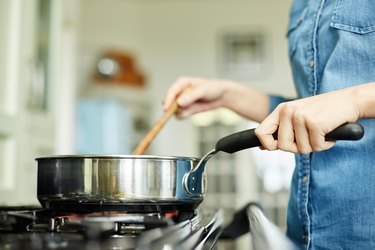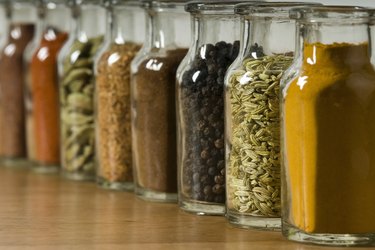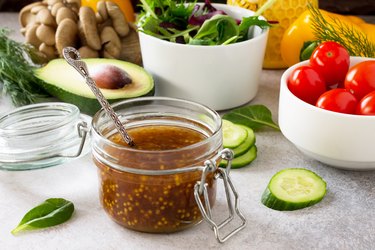
If you're cooking at home in an effort to lose weight, you're already on the right track. Making your own meals — instead of relying on takeout — generally leads to a healthier diet, per a June 2015 analysis in Public Health Nutrition.
But while you're already a step ahead of the game, you might be making a few wrong moves when it comes to how you're cooking and which ingredients you choose. Here are some common kitchen blunders — along with strategies that'll help you right these wrongs during your next culinary creation.
Video of the Day
Video of the Day
1. Free-Pouring Your Oils
Using a bit of fat, like olive oil, helps food cook while adding deliciousness to your meals. But fats are generally calorie-dense foods, so you'll want to take extra precaution to ensure you're not going overboard.
Just one tablespoon of olive oil contains 119 calories, according to the USDA.
It's not that you want to avoid fats entirely. That's especially true for olive oil. Following a diet that includes olive oil led to a greater reduction in weight than a control diet sans olive oil, per a November 2018 meta-analysis in Revista Española de Salud Pública. Still, even with a healthy fat, it's best not to overdo it.
Instead of eyeballing your oils, measure out the amount the recipe calls for — that way, you won't add extra calories that aren't called for in your meal.
Related Reading
2. Overestimating Portion Sizes
One thing that's a little more difficult about eating food at home is that you're in charge of portion control. It'd be wise to familiarize yourself with the foods you cook most often and their proper portion sizes.
To really get the hang of portion sizes, use a food scale, says Tallene Hacatoryan, RD, and founder of PCOS Weight Loss. By taking the time to weigh and measure food — and look at what you're eating — you'll get used to a proper portion size, she says.
What's a Good Portion Size to Keep in Mind?
According to the 2015-2020 Dietary Guidelines for Americans, a healthy and balanced diet for an adult who needs 2,000 daily calories might include the following amounts from each food group:
- Vegetables: 2 1/2 cups
- Fruit: 2 cups
- Grains: 6 ounces
- Dairy: 3 cups
- Protein: 5 1/2 ounces
- Oils: 27 grams
3. Eating the Same Foods Week After Week
Variety, as they say, is the spice of life, and it's particularly important when it comes to your diet.
Consuming the same foods over and over again may take the mental work out of cooking, but it also takes the joy out of eating, and where's the fun in that? Variety is important from a nutritional standpoint, too, since different foods boast different vitamins and minerals.
"Every fruit and vegetable offers something different, so eat the rainbow," Hactoryan says, noting how the various colors of produce are a clue that they provide different benefits.
In fact, having more variety in your diet may put you at a lower risk of metabolic syndrome, which can increase the risk for heart disease, diabetes and stroke, according to a June 2013 study published in Nutrition Research and Practice.
It's possible that changing up your ingredients could also lead to a slimmer waistline. By testing and comparing the stool samples of more than 3,000 twins, researchers determined a strong link between dietary diversity and reduced belly fat, per research published in September 2016 in Genome Biology.
For effortless variety, try buying your fruit and veggies in season. Seasonal produce tends to be more flavorful, nutritious and cost-efficient, as Michigan State University Extension points out, and the rotations around what's ripe will make getting all the colors in your diet a cinch. You could also challenge yourself to attempt one new recipe a week, or ask your friends to send you the recipe for their most beloved dinner staples.
4. Neglecting Your Spice Rack

Cooking with heaps of butter and oil is one way to add flavor to your meals, but a few special spices can also do the trick, without adding extra calories and fat.
While you should feel free to test out all the herbs and spices, some in particular are known to help with weight-loss goals.
- Turmeric: Turmeric, a deep yellow spice that has been used for its medicinal effects for hundreds of years, contains a compound called curcumin, which is known for its strong antioxidant and anti-inflammatory properties. A January 2022 study in the International Journal of Molecular Sciences found that while curcumin is a promising natural bioactive compound, more research needs to be done to determine its connection with weight loss.
- Cinnamon: Cinnamaldehyde, an essential oil responsible for cinnamon's flavor, can benefit fat loss by inducing fat cells to burn energy through thermogenesis, per December 2017 research published in Metabolism.
- Cumin: This spice may have metabolism-boosting properties. In one small November 2014 study published in Complementary Therapies in Clinical Practice, consuming cumin powder helped reduce LDL cholesterol, BMI, fat mass and weight in a group of women who were overweight.
- Cayenne: Cayenne pepper may help reduce appetite and speed up the metabolism. People who consumed capsaicin, the main active ingredient in cayenne, with every meal had fewer cravings and felt fuller, per a small June 2014 study published in Appetite.
Tips for Incorporating Spice Into Your Cooking
Using these kinds of extras to your meals can give new life to healthy foods your taste buds may have once found boring, so don’t be shy. If you're not sure how to get started with spices, incorporate these suggestions from Hactoryan:
- Add cinnamon to smoothies, oatmeal or peanut butter toast.
- Heat up some coconut milk and add some turmeric for a satiating treat.
- Sprinkle some cumin into a blend of black beans, olive oil, salt, lime and shallots for a delicious black bean dip.
- Add cayenne to hearty dishes like chili for an extra kick. It also pairs wonderfully with chocolate, for when the mood strikes!
- Rosemary pairs wonderfully with steak, Hactoryan says
- Mustard seeds, which are very fragrant, are key for a curry dish, like curried cauliflower, Hactoryan says. You could also use them for a homemade salad dressing that packs a punch.
5. Prioritizing Packaged Foods
Packaged foods are convenient when it comes to home cooking; quick dinner fixes like frozen pizza and ready-made sauces can be real time savors.
But these come with a cost, as a December 2017 review published in the Journal of the World Public Health and Nutrition reveals. The review examined a handful of studies that looked at packaged foods' connection with obesity, affirming that consuming ultra-processed foods is associated with obesity and obesity-related cardiometabolic outcomes.
Forgoing frozen pizza does not mean you have to give it up altogether: Research some homemade recipes for your frozen faves, and soon enough you'll find some versions that are way better for your health, and probably tastier than those old freezer fillers.
Related Reading
6. Snacking While You Cook
Why does it always seem we're at our hungriest while we're cooking?
It may feel impossible to avoid taking a bite here and a nibble there while you're concocting something delicious, but those little scraps of food can really add up in the calorie department. Just an ounce of cheddar cheese, for example, contains 110 calories, according to the USDA (and how easy is it really to stick to just an ounce, which is about the size of a pair of dice).
If you're really ravenous, try noshing on something light — like fruit or veggies — to hold you over until the meal is ready.
7. Using Store-Bought Dressings Over Homemade

Making salad dressing at home is nearly as simple as unscrewing the cap from store-bought, and doing so will prevent you from consuming a lot of stuff that can derail your weight-loss goals. Store-bought dressings seem innocent enough, but many of them are packed with saturated fat, excess salt and even hidden sugars, per Harvard Health Publishing, turning your well-intentioned bowl of greens into a diet buster.
For flavor that won't set you back, stick with a measured out mixture of oil and vinegar, or try a squeeze of lemon and some of the new spices you're adopting into your cooking regimen.
Related Reading
8. Relying Too Much on the Salt Shaker
Salt is another calorie-free flavor addition, but it doesn't come without its dangers. High-salt diets are often linked to higher body fat, as one October 2015 study published in Hypertension reveals. Excess salt intake is also associated with high blood pressure, which can lead to cardiovascular diseases.
Researchers have also looked at how salt results in feelings of hunger. An April 2017 study published in the Journal of Clinical Investigation controlled and examined the diets of 10 Russian astronauts training for travel to Mars. In their months-long training, the astronauts were first fed a diet consisting of 12 grams of salt per day (about twice the recommended daily intake). After several weeks, their diets were adjusted to consist of 9 grams of salt per day, and finally 6 grams of salt per day. As their salt intake decreased, the astronauts drank more water. Researchers also noted that when the astronauts were eating more salt, they were more likely to complain of hunger.
Remember: Salt isn't the only option for enhancing the taste of food. Sodium-free spices, low-calorie sauces and citrus all can vastly improve flavors.
9. Not Cooking With Fat
Shying away from certain fats in your cooking could do the opposite of what you're hoping. We need to eat fat to lose fat, so incorporating some healthy fats into your diet, like the kind found in olive oil, nuts and avocado can help give your weight-loss goals a boost.
These healthy fats, aka monounsaturated and polyunsaturated fats, help the body absorb important nutrients and are linked to lowering harmful LDL-cholesterol and protecting the heart, according to the American Heart Association.
Related Reading
10. Failing to Meal Prep or Plan
If you have all of the ingredients you need to cook a healthy recipe, you're more likely to cook (and eat) said recipe. So do your future self a favor and plan ahead: Do some recipe research, write a list and make time for the grocery store.
Meal preppers tend to get more variety in their diets (eat the rainbow!) and, for women especially, meal planning is linked with lower odds of being overweight, per February 2017 research published in the International Journal of Behavioral Nutrition and Physical Activity.
- Revista Española de Salud Pública: "Olive Oil and Body Weight. Systematic Review and Meta-Analysis of Randomized Controlled Trials"
- USDA: "Oil, olive, salad or cooking"
- Public Health Nutrition: "Is cooking at home associated with better diet quality or weight-loss intention?"
- 2015-2020 Dietary Guidelines for Americans: "Healthy U.S.-Style Eating Pattern at the 2,000-Calorie Level, With Daily or Weekly Amounts From Food Groups, Subgroups, & Components "
- Nutrition Research and Practice: "A healthy dietary pattern consisting of a variety of food choices is inversely associated with the development of metabolic syndrome"
- Genome Biology: "Heritable components of the human fecal microbiome are associated with visceral fat"
- Michigan State University Extension: "7 benefits of eating local foods"
- Metabolism: "Cinnamaldehyde induces fat cell-autonomous thermogenesis and metabolic reprogramming"
- Complementary Therapies in Clinical Practice: "Effect of cumin powder on body composition and lipid profile in overweight and obese women"
- Appetite: "Capsaicin increases sensation of fullness in energy balance, and decreases desire to eat after dinner in negative energy balance"
- Journal of the World Public Health and Nutrition: "Ultra-processed Food Intake and Obesity: What Really Matters for Health – Processing or Nutrient Content?"
- USDA: "CHEDDAR CHEESE"
- Harvard Health Publishing: "Is your salad dressing hurting your healthy diet?"
- Hypertension: "High salt intake: independent risk factor for obesity?"
- Journal of Clinical Investigation: "Increased salt consumption induces body water conservation and decreases fluid intake"
- American Heart Association: "The Facts on Fats Infographic"
- International Journal of Behavioral Nutrition and Physical Activity: "Meal planning is associated with food variety, diet quality and body weight status in a large sample of French adults"
- International Journal of Molecular Sciences: "Curcumin and Weight Loss: Does It Work?"